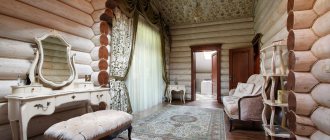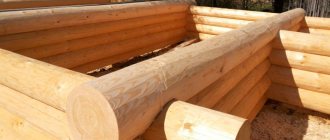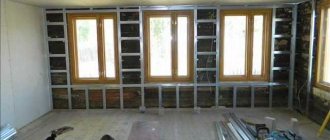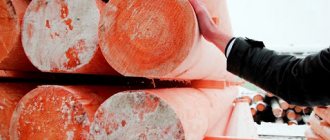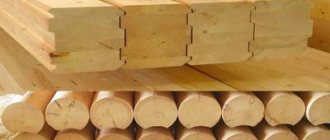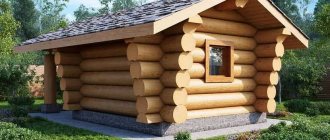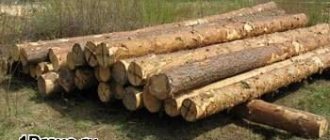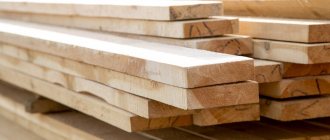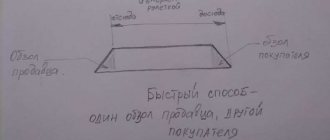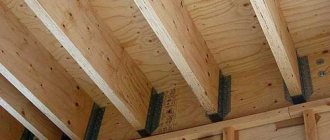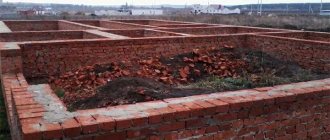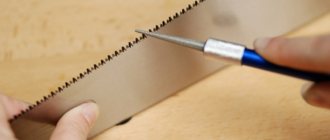Rounded logs are an ideal material for building a bathhouse or a country house. Such products are distinguished by environmental friendliness and safety, attractive appearance and quick installation, ease of installation and processing. Due to special manufacturing technology, logs acquire a perfectly flat cylindrical shape and smooth surface, identical diameters and dimensions.
Thanks to these parameters, the products are stacked closely, which eliminates the appearance of cracks in the log house. In addition, the construction of a house or bathhouse is easy and quick. A log structure will look elegant and neat.
How to calculate volumes of materials
For those who decide to build a log house, it is important to correctly calculate the required amount of building materials. Since logs are characterized by a cylindrical shape, calculations must be made based on this parameter. You cannot calculate the volume by simply multiplying the thickness of the walls by the height. To do it yourself correctly, use a special cubical of rounded logs.
The simplest calculation is carried out using the formula = P*R2*N, where
P
= 3.14;
R2
is the radius of the rounded log squared;
H
is the length of the rounded log.
We multiply the result obtained by the number of logs needed to build a house or bathhouse. Do not forget to add 7%, which is allocated for the shrinkage of the log house. To facilitate the calculation, the results for different log diameters are presented in a table of log cubic capacity.
Example of a calculation algorithm
The algorithm for obtaining data is practically easy to implement. For example:
- Based on the drawing of the premises, we calculate the total amount of lumber (round timber) that will be used in the construction of the planned building.
- When determining the quantity, we take into account the required (or desired) thickness of the timber (that is, their diameter).
- We measure the average volume of the log. Knowing the total quantity that is available, we obtain the final volume of round timber that is needed for construction. We calculate the approximate volume of the log using the formula (see above) or using the table.
Table of cubic capacity of rounded logs 6 meters long
| Diameter, mm | Height, mm | volume, m3 | Area, m2 | Quantity in m3, pcs. |
| 140 | 130,6 | 0,09 | 1,453 | 11,1 |
| 160 | 149,2 | 0,12 | 1,662 | 8,29 |
| 180 | 167,9 | 0,15 | 1,869 | 6,55 |
| 200 | 186,6 | 0,19 | 2,078 | 5,31 |
| 220 | 205,2 | 0,23 | 2,286 | 4,39 |
| 240 | 223,9 | 0,27 | 2,493 | 3,69 |
| 260 | 242,5 | 0,32 | 2,701 | 3,14 |
| 280 | 261,2 | 0,37 | 2,908 | 2,71 |
| 300 | 279,9 | 0,42 | 3,117 | 2,36 |
| 320 | 298,5 | 0,48 | 3,325 | 2,07 |
| 340 | 317,2 | 0,54 | 3,532 | 1,84 |
| 360 | 335,8 | 0,61 | 3,74 | 1,64 |
The volume and cost of materials is affected not only by the type of wood, but also by the diameter of the log. If you are planning to build a house for permanent residence, choose dimensions of at least 240 mm, and for the northern regions - more than 260 mm. If this is a summer cottage for seasonal living and recreation, logs with a diameter of 220 mm will be suitable. For a gazebo, you can take the minimum dimensions.
The table is not the only way to calculate the required amount of building materials. There is a special online calculator that will make a quick and accurate calculation of the quantity and cost of materials, taking into account shrinkage, internal partitions and other factors.
In addition, the calculator will calculate the usable area of the room, the number of crowns and the load on the foundation. As a rule, on the websites of construction companies, each standard project comes with its own calculator.
If you don’t know how to correctly calculate the cubic capacity of logs, the specialists of the MariSrub company will help you! Experienced craftsmen will select and calculate the volume of materials. Experts recommend choosing rounded pine logs, as this is the best price-quality ratio.
Pine is an affordable, strong wood that is distinguished by strength and durability, a pleasant pine aroma and beautiful texture. Choose your favorite option for a log house or order an individual project! Specialists will prepare a free estimate for your future home or cottage, calculate the volume of materials and the cost of construction.
An important condition for any construction is an accurate accounting of the need for material. This is necessary for preparing estimates, calculating transportation costs, choosing a supplier and many other factors. Accordingly, when building log houses, the relevant question is how many rounded logs are needed per house. To roughly answer it, you don’t have to be a construction specialist; it’s enough to use tables and simple calculations.
Calculate the amount of rounded logs
So, to determine the cubic capacity of a rounded log, Table 1 provides the initial data:
Table 1. Cubic of rounded logs
| D, mm | B, mm | L, m | V, m³ | B, mm | L, m | V, m³ | B, mm | L, m | V, m³ |
| 180 | 90 | 6,39 | 0,162 | 108 | 6,94 | 0,177 | 120 | 7,41 | 0,188 |
| 200 | 100 | 5,75 | 0,180 | 120 | 6,25 | 0,196 | 133 | 6,67 | 0,209 |
| 220 | 110 | 5,22 | 0,199 | 132 | 5,68 | 0,216 | 147 | 6,06 | 0,230 |
| 240 | 120 | 4,79 | 0,217 | 144 | 5,21 | 0,236 | 160 | 5,56 | 0,251 |
| 260 | 130 | 4,42 | 0,235 | 156 | 4,81 | 0,255 | 173 | 5,13 | 0,272 |
| 280 | 140 | 4,11 | 0,253 | 168 | 4,46 | 0,275 | 187 | 4,76 | 0,293 |
| 300 | 150 | 3,83 | 0,271 | 180 | 4,17 | 0,294 | 200 | 4,44 | 0,314 |
| 320 | 160 | 3,59 | 0,289 | 192 | 3,91 | 0,314 | 213 | 4,17 | 0,335 |
| 340 | 170 | 3,38 | 0,307 | 204 | 3,68 | 0,334 | 227 | 3,92 | 0,356 |
| 360 | 180 | 3,19 | 0,325 | 216 | 3,47 | 0,353 | 240 | 3,70 | 0,377 |
| 380 | 190 | 3,02 | 0,343 | 228 | 3,29 | 0,373 | 253 | 3,51 | 0,398 |
| 400 | 200 | 2,87 | 0,361 | 240 | 3,13 | 0,393 | 267 | 3,33 | 0,419 |
- D – log diameter, mm.
- B – groove width, mm.
- L – required number of linear meters of logs per 1 m2 of log house wall, linear meters.
- V – volume of logs required per 1 m2 of log house, m3.
From all this, knowing the diameter of the logs, for example 240 mm, and the width of the groove - 120 mm. you can calculate the required number of cubes and linear meters. So, for a house 10x10 m and 3 m high, the wall area is 4 (number of walls) x10x10x3 = 1200 m2. Next, according to the data in Table 1, we determine how many rounded logs are needed per house: 1200x4.79 = 5748 l.m.
With a standard log length of 6 m, we get 958 logs. Naturally, these data are approximate, and a reasonable margin is necessary. In the same way, according to table. 1. We determine the approximate volume of rounded logs: 1200x0.217 = 260.4 m3.
This is necessary for making purchases, since the price is usually indicated per cubic meter.
About cost and other factors
An important issue, of course, is the cost of the material. You can roughly determine how much a cube of rounded log costs using the table. 2.:
Using it you can also determine how many meters there are in a cube of rounded logs. So, for the same diameter of 240 mm with a log volume of 6 m long of 0.2714 m3, we obtain: 1/0.2714 = 3.7 logs or approximately 4 logs.
It is also worth mentioning the choice of log diameter. It is selected in accordance with existing SNiP, taking into account that the thermal conductivity of a log across the fibers is 0.15 and the lower the moisture content of the material, the lower it is and, accordingly, the warmer your home will be. It is also necessary to remember the ratio of the groove width to the diameter. The thickness of the narrow part of the wall depends on this, which also affects the thermal insulation of the room.
- Converting the calculated number of logs from pieces to cubes
- Technology for counting logs in cubes
- Determining the number of rounded logs with a groove
Everyone knows about the advantages of wooden housing (ecology, thermal insulation, controlled humidity, etc.). In addition to these properties, its cost also speaks in favor of the tree.
A rounded log is wood that has been processed on a production machine. It has a round shape and a smooth surface.
A brick dacha, for example, is much more expensive. And the process of building a house from rounded logs is much faster and easier.
General information on the calculation results
- ABOUT.
total log volume
- P.
perimeter of the building
- P.
usable area of the room
- ABOUT.
total area of external walls
- ABOUT.
total weight
- TO.
number of crowns
- TO.
quantity of roll insulation for all crowns
- D.
Diameter and number of dowels in 1.5 meter increments
- TO.
Amount of impregnation on both sides
- P.
approximate shrinkage (7%) of rounded logs
- N.
load on the foundation from the walls
– Estimated amount of lumber in cubic meters.
– The total length of all walls, taking into account the protrusion of the corners (foots).
– The area of the room, taking into account the deduction of the output and the thickness of the log.
– The area of the outer side of the walls. Corresponds to the area of the required insulation, if provided for by the project.
– Weight of the log excluding insulation.
– Number of rows of logs in the wall. Depends on the height of the walls and the size of the material used.
– Equal to the total length of all logs.
– This calculation is only suitable for lightly loaded log buildings. For critical buildings, the calculation of dowels must be carried out by specialists in your region.
– The calculated amount of protective impregnation of medium grades, covering the external and internal surfaces of all walls.
– Approximate shrinkage of walls made of rounded logs after 1 year, with an initial humidity of 20%.
– Load without taking into account the weight of the roof and ceilings, with support on the entire surface of the lower crown. This parameter is necessary to select the strength characteristics of the foundation.
Building your own house from rounded logs is the best option when you need to get good performance characteristics at reasonable prices. You can carry out the work yourself or seek the help of specialists, but you must first calculate the required amount of building materials. This will save both time and money.
[my_custom_ad_shortcode3]
Converting the calculated number of logs from pieces to cubes
If you decide to build a log house, then in order not to delay construction due to a lack of materials, you should decide in advance on the size of the hut and determine how much timber it will require. Calculating, for example, the number of logs needed for walls is not so difficult. Let it be a house 6 by 6 meters at the base and 3 m high. The dimensions were chosen for convenience, because logs on sale are 6 m long. The diameter of their cross-section ranges from 18 cm to 30 cm, maybe more. The most popular of them is 24 cm.
Exactly one pillar is laid along one wall, and along the height of the wall - 3 m: 0.24 m = 12.5 or as many as 13 pieces. The house in this example has all equal sides, which means that in total you will have to buy 13 x 4 = 52 pillars. The price of timber is set in cubic meters. Therefore, “pieces” should be translated into “cubes”.
This can be done as follows. A rounded log has the same cross-sectional diameter throughout its entire length. Cylinder volume formula:
V = 3.14xr 2 x L,
where V is the desired value, 3.14 is a constant number, r is the cross-sectional radius of the log, L is its length. In this case, it turns out that the volume of one trunk will be equal to:
V 1 = 3.14 x (0.24: 2) 2 x 6 = 3.14 x 0.0144 x 6 = 0.271 m 3.
It has already been determined that the construction of the walls of a wooden hut measuring 6 x 6 meters requires 52 logs. Then in cubes you will need:
V 0 = V 1 x 52 = 0.271 m 3 x 52 = 14.092 m 3.
An example of the calculation is given practically for a well house; the presence of windows and doors was not taken into account.
The dimensions of all openings must be taken into account during calculations.
Just for clarity, we took such lengths of the sides that it would not be necessary to saw the board to size.
Return to contents
Simple calculation
It would seem, based on school knowledge, nothing is simpler. Having found out the length, height and width of a log or beam, you can simply multiply and get the result of the dimensions of a wooden box. However, the diameter of the material must not be overlooked; it directly affects the final figure and width of the compensation cut, which leaves the original size of the logs, but significantly reduces the amount of wood.
It becomes clear that calculating the volume of a log house is not a very simple matter, especially taking into account the methods of connecting the corners - with and without the remainder. But still feasible. So, we have the desired size 6×6 and using this example we will analyze the required quantity:
- First of all, you need to understand that a larger diameter of logs will ultimately be a plus in the overall cost of money. After all, a built house will cost with a smaller layer of insulation, or even without it at all.
- Next, the height of the log house. It is impossible to calculate the frame for a house without taking into account the height. Usually it is 2.4 m per floor in the pure internal version.
But let’s take an external height of 3 m as the required quantity. Now it’s not difficult to calculate the logs for one wall - 3/0.26 = 11.5 pcs. Round up to 12 and add the base crown element. Total number of logs per wall = 13 pcs.
- Now let's make calculations for all the walls of the log house. Let's take a five-wall structure as an example, since the lengths of the sides are the same, it is not difficult to calculate a log house by the number of logs - 13 × 5 = 65 pieces. That is, to build a 6x6 house with a log diameter of 26 cm, 65 logs will be required.
But the material is not purchased individually. For this there is such a measure as volume. Of course, you can go to a sawmill and point your finger at the logs to indicate what material is needed, but it will look more than strange.
- Using the well-known school formula - π*R²*L, we find the volume of one log. Multiplying the data - where R is the radius of the deck, and L is the length, we get the result 0.32 m³.
It is now easy to calculate the cubic capacity of the entire log house - 0.32*65=20.8 m³. That is, for a 6x6 house, a one-story five-wall building, 3 m high, approximately 21 m³ of forest will be required.
To this should be added the costs of the foundation, rafter system and finishing, which together can increase the project amount by more than 2 times. By the way, you can calculate a log house using the example given, and its cost is lower than a log.
Technology for counting logs in cubes
Calculations can be carried out immediately in cubic meters. In this case, the value is determined in cubic meters. one crown of a log cottage, then this value is multiplied by the number of all crowns. For example, we again take a house 6 by 6 meters. The bottom row of this hut consists of 4 trunks with a total length of 24 m. Its volume is equal to: V 1 = 3.14 x (0.24: 2) 2 x 24 = 1.085 m 3. The total volume of 13 rows will be: V 0 = V 1 x 13 = 1.085 x 13 = 14.092 m 3. This method is simpler and faster, but for greater confidence and self-control it is better to know how much round timber is needed for the house and in pieces, and not just in cubes.
Both calculation methods described above are given for corner joints of a log house “in the paw”, i.e. without protruding ends at the corners. If “bowl” installation is used during construction, then the ends of the logs will protrude 25 cm in each corner.
Then for a hut of the same dimensions, pillars 6.5 m long will be required. The volume of one crown will be equal to: V 1 = 3.14 x r 2 x (4L) x = 3.14 x 0.0144 x (6.5 x 4) = 0.0452 x 26 = 1.175 m3. The total amount of timber will be: V 0 = V 1 x 13 crowns = 1.175 x 13 = 15.27 m 3. It turns out that when connecting the trunks “into a bowl”, more forest will be required. In addition, when purchasing, you need to remember about possible defects, errors during sawing, etc. and purchase 3-5% more timber.
16.06.2014 21:04
After all the ideas for implementing the construction of a house have been worked out and the final option for building a house from rounded logs has been selected, the question arises how much such a house will cost you. To determine the cost of building a log house from rounded logs ,
you need to know how many cubes of logs are in this log house. In this article we will try to explain in detail how to calculate the cubic capacity for the construction of rounded logs.
Calculation of cubic capacity of rounded logs
The simplest method of calculation is made using the formula - πr². H
Π –
3,14
r² –
radius of a rounded log squared
N –
length of rounded log
Substitute the data into the formula:
3.14 *(0.11 m)²* 6m= 0.228 m3
So, we got how many cubes are in one rounded log with a diameter of 220 mm. Next, you need to calculate the number of logs in your house and multiply the resulting amount by the cubic capacity of one log (0.228 m3). You can easily count the number of logs in a wall, but initially you need to determine for yourself how high the floor will be. It is also necessary to add 7% to the resulting height for shrinkage
, if the log has natural moisture.
For example, the height of the first floor is 2.9 meters. The height of one log is 220 mm minus the lunar groove will be 190.5 mm. Next, we divide the floor height of 2.9 m by the thickness of the log without a groove - 0.19 m, having previously converted all the numbers into meters.
2.9: 0.19 = 15.26 pieces. We received the required number of logs with a diameter of 220 mm in order to build a floor with a height of 2.9 meters. You must not forget to add 7% for shrinkage of the house. In total you will get 16 crowns. Now, to find out the full volume of the floor of a 6x6 house, 16 crowns high, you need to perform the following calculation:
16 (crowns) * 4 (walls) * 0.228 (volume of one log) = 14.6 m3 of logs. Now, to find out the cost of a rounded log for the entire log house, you need to multiply the number of cubes obtained by the price of the log for one cube. The cost of one meter of cubic rounded log can be found out.
To perform calculations for other log diameters, we offer you a number of pre-calculated tables, using which you will certainly find answers to your questions.
The article was prepared by ASK Egida
, which carries out the construction of houses from logs
and provides
a wide range of construction services
in the suburban housing construction market.
Let's start with the fact that the table - how many logs are in 1 cube will never be accurate, since such a profile has a round, sometimes irregular shape, and besides, any wood is prone to swelling and shrinking when air humidity changes.
Nevertheless, such calculations exist, although calculations for such lumber as edged boards, solid and laminated timber would be more accurate here. We will try to tell you more about the types of lumber and provide tables, as well as demonstrate a video in this article.
Board, timber, log
Introduction to lumber
- Everyone knows what a board is, especially since most of us see such a profile every day (or structures made from it), but not everyone realizes that its price depends on the type and assortment. We will not talk about the assortment now, but we will point out the three most common types - these are edged, unedged and one-sided edged boards, which can have different widths and thicknesses and can be made from. There is also the so-called croaker obapole or slab - these are boards that are not completely sawn and on one side there is usually the upper part of the trunk along with the bark.
Note. It should be noted that often a board of 100×50 mm or, for example, 120×50 mm is perceived as timber, but such a profile in any case remains a board.
- The instructions call a beam a trimmed profile with a cross section of at least 100 mm; thinner profiles belong to the category of bars, and those less than 30 mm belong to the category of slats. Such lumber can be either solid wood or glued together from lamellas (boards or plywood) - its performance qualities, such as strength and water repellency, largely depend on this. In addition, it can have a different profile, since it is usually used for the construction of walls and partitions.
- A tree trunk, if it is long enough, can be divided into three parts - the lower one is the butt, the middle one is the drug, and the upper one is either the top or the third, but any of these parts has a larger section at the bottom and tapers at the top. In addition, the circumference of the trunk is far from ideal, therefore, if you calculate how many cubes of logs are needed for a 10x10 house, the answer may turn out different each time. A completely different matter is a rounded log, where after processing the trunk on a special machine, an almost perfect round timber is obtained, where the circumference along the entire length is maintained down to a millimeter.
Making calculations
Note. As we have already said, sawn materials with right angles (timber, timber, slats or boards) are much easier to calculate, since when laid they occupy almost the entire space. But how much a cube of a log is will be accompanied by some explanations.
| Cross section of the board in mm | Number of pieces per m 3 with a board length of 6 m | The volume of each board is 6 m in m 3 |
| 25x100 | 66,6 | 0,015 |
| 25x120 | 55,5 | 0,018 |
| 25x150 | 44,4 | 0,022 |
| 25x200 | 33,3 | 0,03 |
| 40x100 | 41,6 | 0,024 |
| 40x120 | 34,7 | 0,0288 |
| 40x150 | 27,7 | 0,036 |
| 40x200 | 20,8 | 0,048 |
| 50x50 | 66,6 | 0,015 |
| 50x100 | 33,3 | 0,03 |
| 50x120 | 27,7 | 0,036 |
| 50x150 | 22,2 | 0,045 |
| 50x200 | 16,6 | 0,06 |
| 50x250 | 13,3 | 0,075 |
Edged board calculation table
| Cross section of timber in mm | Number of pieces per m 3 with a beam length of 6 m | The volume of each board is 6 m in m 3 |
| 75x150 | 14,8 | |
| 100x100 | 16,6 | 0,06 |
| 100x150 | 11,1 | 0,09 |
| 100x200 | 8,3 | 0,12 |
| 150x150 | 7,4 | 0,135 |
| 150x200 | 5,5 | 0,18 |
| 150x300 | 3,7 | 0,27 |
| 200x200 | 4,1 | 0,24 |
Calculation table for solid timber
Table - how many cubes are in a rounded log
In fact, everything turns out to be much simpler than it looks at first glance, and the very first step is to calculate the volume of one log using the formula πr 2 *H. As everyone knows, the number π has a value of 3.14, r is the radius of the object being counted, and H is its length.
For example, let’s calculate the volume of the thickest rounded log with a cross section of 320 mm, but since we are interested in cubic capacity, we will carry out calculations in meters, which means that our diameter will be 320 mm = 0.32 m, and the radius will be 0.32 /2=0.16m. Now we count 3.14 * 0.16 2 * 6 = 0.482304 m 3 . Consequently, in one studied object we obtained a volume of 0.482304 m 3.
You can also calculate construction timber in the same way, but there you will not be able to get accurate calculations for the reasons that we have already mentioned above - narrowing of the trunk and blurred cross-section.
But here we can make allowances for the fact that the butt (lower) part of the trunk is used for construction, and there the narrowing is least noticeable, so here calculations can be done with the smallest allowances.
Method two: formula
This calculation method is most suitable for timber that is approximately the same in length and has a diameter similar to each other. The following formula is used for calculations: π *R*L, where π is equal to 3.14, R is the radius of the log, and L is its length.
Advice: building materials in the form of logs, of course, have a similar diameter, but still slightly different from each other. And in order to get the most accurate result, it is necessary to measure the volume of any three units from the batch - according to the above formula. And then these parameters are summed up and divided by 3. We get an average number. We multiply the resulting numbers by the number of logs at our disposal and get the volume.
